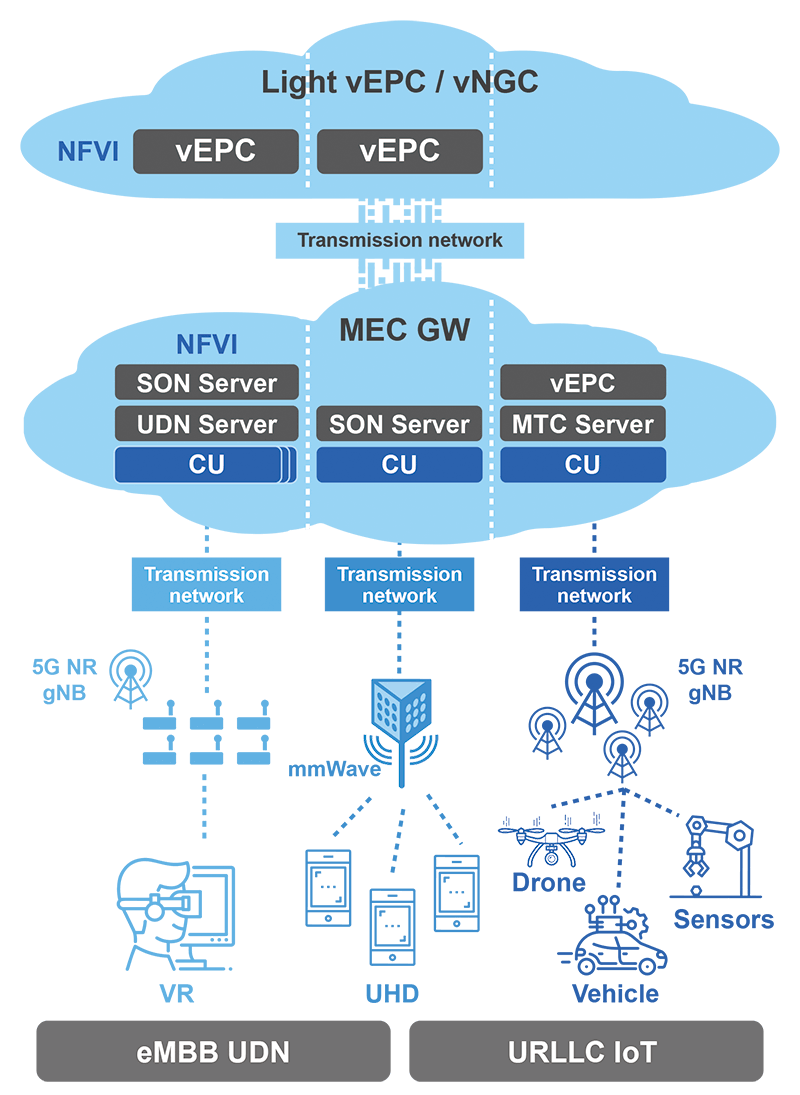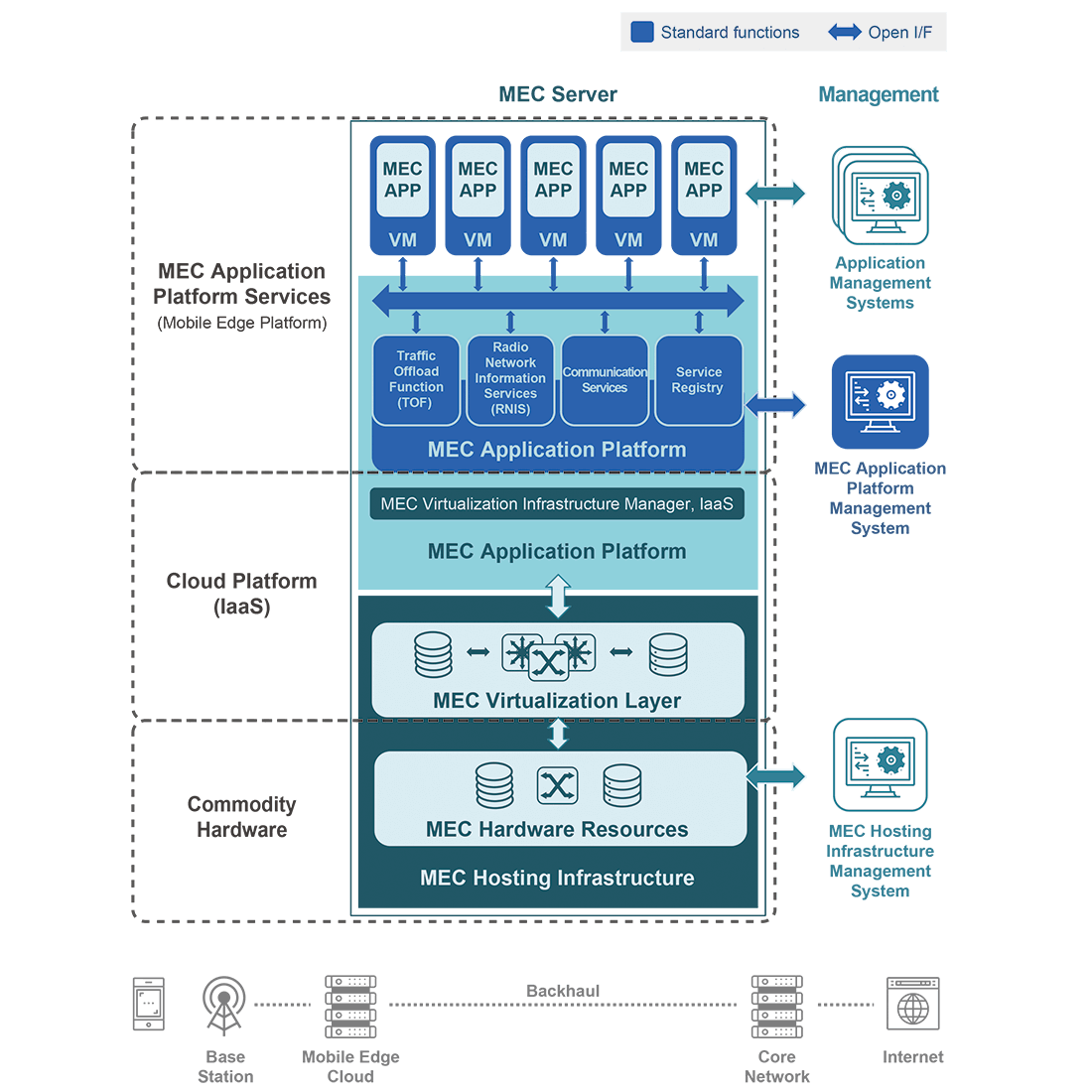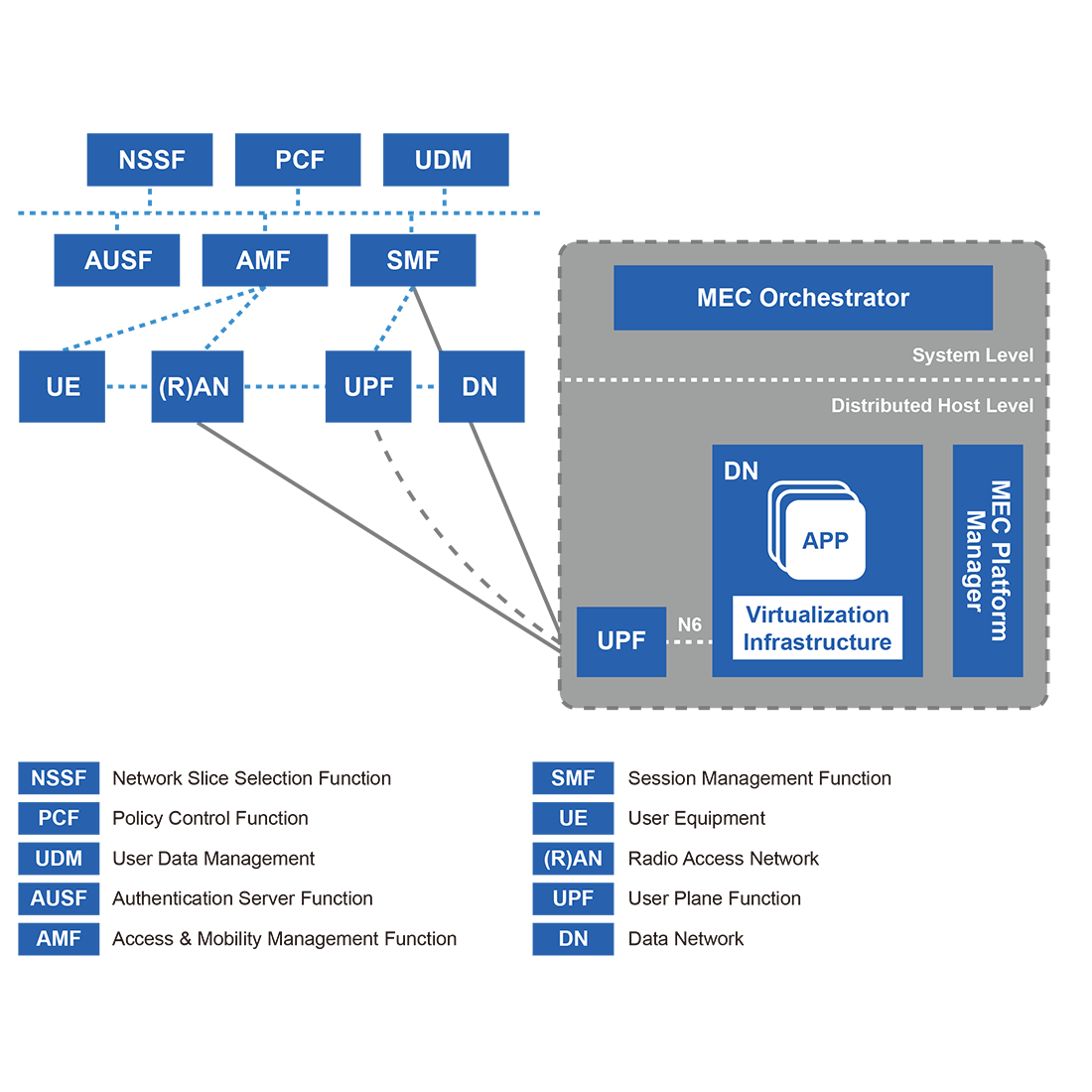5G MEC Networking Platform
A MEC (Multi-access Edge Computing / Mobile Edge Computing) platform based on GIGABYTE's server hardware provides an effective way to support a new generation of 5G services such as eMBB for high bandwidth content streaming, URLLC for autonomous driving or mMTC for a smart city IoT network
Download White Paper
Introduction
In order to upgrade their infrastructure to meet the latency and Quality of Service (QoS) requirements of 5G while reducing costs, commercial or private network operators can implement a MEC (Multi-access Edge Computing / Mobile Edge Computing) architecture, and utilize Network Functions Virtualization (NFV) together with general purpose servers to implement Virtual Evolved Packet Core (vEPC) technology, replacing expensive proprietary hardware and software. GIGABYTE's server products provide an effective hardware base to implement a MEC solution.
Network & Cloud Virtualization at the Edge
A MEC server platform combines NFV and Cloud Virtualization technology to minimize mobile backhaul bandwidth requirements and provide an ultra-low latency edge cloud platform.
Adopting a MEC network architecture based on GIGABYTE servers to replace propriety networking hardware and software is an ideal way to reduce infrastructure costs while enabling network operators to successfully transform their 4G network to support 5G technology.
Autonomous Driving
Data from the vehicle's sensors and external traffic conditions from the cloud needs to be combined and processed in a split second and transmitted back to the onboard vehicle computer to make a decision to turn, brake etc. There is not enough time for this data to travel back to a central cloud to be processed. Mobile Edge Computing can process and transmit back the data in a timely manner.

Mobile AR / VR
AR & VR require powerful graphics processing capabilities which have previously relied on local compute / GPU host servers physically located next to the user. 5G and Mobile Edge Computing will allow the user to experience high definition and low latency AR / VR using only a lightweight mobile headset or device.

Massive IoT Network
The high bandwidth and low latency of 5G networks will allow for a mMTC (Massive Machine-Type Communications) IoT network. However, this huge amount of data will place a heavy strain on network backhaul capacity if it needs to be transmitted back to the cloud to be processed. MEC solves the backhaul issue by processing and re-transmitting the data at the network edge.

The Challenge of Implementing 5G
5G - the next generation of mobile telecommunications technology, is on the horizon and promises to deliver a myriad of new services and capabilities such as Enhanced Mobile Broadband (eMBB), Ultra Reliable Low-Latency Communications (URLLC) and Massive Machine-Type Communications (mMTC). A new band of the radio frequency spectrum between 30 – 300GHz has been opened for use, and a new telecommunications standard for 5G has been defined encompassing network speed, latency, the number of devices that can be connected, QoS and other conditions.

4G LTE vs. 5G and eMBB
However, enabling 5G technologies requires not just a simple upgrade of User Equipment (UE) with a 5G modem and front end Radio Access Network (RAN) equipment. To meet the specifications of 5G such as speed, end-to-end latency and QoS, network operators will need to upgrade their entire front to back-end network topology. Upgrading this network infrastructure to enable technically complex 5G service could be extremely costly. In addition to the spectrum purchase cost, infrastructure investment costs will be huge: the number of base stations required for deployment will be four times that of the past, and construction costs will be 10 to 20 times higher than that of the 4G period.
The Solution: A GIGABYTE MEC Server Platform

MEC Network Topology
Reduction of Infrastructure CAPEX and OPEX
The market size of general-purpose server equipment is much larger than that of dedicated telecommunications equipment. Therefore, the initial purchase cost will be lower, and performance / price ratio will be higher. A MEC platform can help reduce Capital Expenditure (CAPEX) for building a 5G network to be more in line with market expectations.
Using a MEC network topology, the data uplink / downlink between the base station and the core network will no longer be needed to support such a heavy load of local IP traffic. Therefore, private lines or dark fiber leases can be changed to general internet access links, allowing more competitive operating expenses (OPEX) .
Better Service Quality
A MEC server features Virtualized Evolved Packet Core (vEPC) functionality, allowing the UE to change signals between base stations without having to go back to the core network to complete the inter-base station handover. Only after the successful handover, will the necessary information be returned to the core network EPC. This can improve the 5G network service quality, especially when the user is moving at high speed.
High Reliability
A MEC server provides redundancy at the infrastructure level with NFVI, without relying on physical modules. The abstract nature of cloud virtualization resources ensures the virtual network functions (VNF) running on it will not be affected by service interruptions due to physical server or network connection errors. For example, EPC key network entities such as Mobility Management Engine (MME) VMs can run multiple copies, with hot standby technology providing N+1 backup for each other. If the main VM fails, the standby VM can take over within a fraction of a second, without the user feeling the EPC service has been temporarily interrupted.
Network Maintainability
5G Standards include specifications for a wireless IoT (mMTC: Massive Machine-Type Communications) - which places a huge burden on a network's Evolved Packet Core (EPC) in terms of system scale and scalability. The MEC platform can form a QoS policy through the Policy and Charging Rules Function (PCRF) network entity. The Software Defined Networking (SDN) controller will convert this policy to a ruleset, that will be published to the topology of the switch that groups traffic, and will use a Virtual Local Area Network (VLAN) method to manage operations.
High Scalability
Virtualization technology allows a MEC server to flexibly increase or decrease resource usage according to demand, so as to effectively utilize the overall resources. And in addition to the above-mentioned aspects of providing redundancy protection in NFVI, virtual resources and VNF can be dynamically managed, including the addition and removal of VMs, ensuring that every vEPC running can maintain proper configuration and operation.
The Core Value of MEC
A MEC platform can support a heterogeneous configuration of an ultra-dense 5G RAN with various vertical services, serving as an ingress point from the RAN to the core network as well as performing Self Organization Network (SON) functionality for the RAN, and local traffic breakout to offload traffic toward the core network. It is designed to minimize end-to-end delay, perform QoS negotiation/management with the RAN and the Software Defined Networking (SDN) / NFV based core network, and also manage some virtualized RAN functions.
Due to the rapid deployment capabilities of virtualized / cloud computing, the network entity setup / configuration period for the core network can be greatly shortened using the MEC platform. Virtualized devices can also be easily scaled out according to additional demand and remotely & dynamically updated, ensuring a greatly reduced system maintenance burden. Furthermore, the load balancing capabilities of cloud computing further improves QoS. In addition to the migration and re-generation ability of Virtual Machines (VMs), a hot standby feature (in addition to the main VM, a redundant spare will also be available to take over) ensures a high level of network reliability.
Due to the rapid deployment capabilities of virtualized / cloud computing, the network entity setup / configuration period for the core network can be greatly shortened using the MEC platform. Virtualized devices can also be easily scaled out according to additional demand and remotely & dynamically updated, ensuring a greatly reduced system maintenance burden. Furthermore, the load balancing capabilities of cloud computing further improves QoS. In addition to the migration and re-generation ability of Virtual Machines (VMs), a hot standby feature (in addition to the main VM, a redundant spare will also be available to take over) ensures a high level of network reliability.

5G E2E (end-to-end) System Architecture
MEC Platform Features
1. Hypervisor-Based and Container-Based Hybrid NFV FunctionsA MEC platform can support both OpenStack NFV (OPNFV) and Kubernetes NFV Infrastructure (NFVI) solutions, providing a unified management interface for virtual machine and container application services, and providing application services for easy and quick deployment.
2. Service / Traffic Offload
Acting as a System Architecture Evolution (SAE) gateway, the MEC provides dynamic path judgment and can support the following usage scenarios:
・Traffic offload function for the specified Access Point Name (APN)
・If the user uses the MEC service, the packet is directed to the NFV platform of MEC.
・If the user is not using the MEC service, the packet is directed to the Packet Data Network Gateway (P-GW) and connected to the Internet through the carrier's core network.
3. Seamless Service Redirection
2. Service / Traffic Offload
Acting as a System Architecture Evolution (SAE) gateway, the MEC provides dynamic path judgment and can support the following usage scenarios:
・Traffic offload function for the specified Access Point Name (APN)
・If the user uses the MEC service, the packet is directed to the NFV platform of MEC.
・If the user is not using the MEC service, the packet is directed to the Packet Data Network Gateway (P-GW) and connected to the Internet through the carrier's core network.
3. Seamless Service Redirection
Seamless
Service Redirection can work with various cloud platforms such as AWS, Google Cloud etc. to meet the low latency requirements of 5G application services. The application service can seamlessly run on the MEC platform, and the user application can connect to the application service of the MEC platform without any modification needed.

iMEC Platform Features
4. Just-In-Time Service Initiation
The MEC is a distributed cloud platform with limited system resources, as opposed to a more traditional data center cloud. Therefore, in order to make more effective use of these limited resources, the MEC features Just-In-Time Service Initiation technology, so that application services can start dynamically when needed and shut down when not in use, reducing resource idleness. A containerized application service can be dynamically launched within 1 second.

iMEC Structure
hide
hide
GIGABYTE Servers as the Hardware Base of a MEC Platform
GIGABYTE offers a range of server solutions ideal to be used as a MEC platform. These range from compact edge server platforms such as the H242 Series which can be deployed at base station towers, to larger and more powerful platforms such as the G291-Series (G291-280 / G291-Z20) or the G591-HS0 which feature GPU acceleration to be used for AR / VR or mobile gaming applications that can be deployed at aggregated edge data centers.
1/7
Edge Server
Ampere® Altra® Max Processor 2U - 6 x low-profile slots | Application: AI Inference & Edge
2/7
Edge Server
1U short depth AMD EPYC™ 7003 series server system | Application: AI , AI Inference & Edge
3/7
Edge Server
1U 3rd Gen. Intel® Xeon® Scalable server system | Application: AI & Edge
4/7
MEC Edge Server
Short depth chassis for far edge deployments such as a base station tower
5/7
MEC + VR Stitching & Processing Server
Up to 32 x GPU cards to deploy as a combined MEC / VR stitching & processing server to deploy at stadiums for live video / VR streaming that can be routed locally
6/7
MEC Edge AI Server
Up to 4 x GPU cards for an AI inferencing + MEC server platform at the aggregated edge
7/7
MEC Edge Server
Short depth chassis for far edge deployments such as a base station tower
Related Technologies
5G is short for "5th Generation", the name for the next generation of mobile cellular networks. 1G networks brought us the first cell phones, 2G networks allowed for text messaging, and 3G networks introduced mobile internet for the first time. Currently in use is 4G which has been deployed globally since 2009. 4G LTE (Long Term Evolution) is the latest version of 4G that allows a download rate of up to around 200Mbps. However, 4G networks have just about reached the limit of their capabilities at a time when users want even more data and faster speeds for their cell phones and other devices. Therefore, the need for a new type of network technology that can provide faster speeds and transmit more data to more users is pressing.
Technically speaking, "5G" is defined only as a set of standards – such as latency, network connection density, and data transfer rate – that the next generation of mobile networks should be able to achieve. Once these standards can be met, 5G should be able to handle up to 1000 times more traffic than today's networks, and be up to 10 times faster than 4G LTE.
To be able to meet these standards, various new technologies will be needed. For example, to support a huge increase in the number of online devices, a new band on the radio frequency spectrum (between 30 – 300GHz) will be opened for use. However, this band of radio frequency consists of "millimeter waves" which are more easily blocked by buildings and absorbed by plants and rain. Therefore, thousands of small base stations ("small cell technology") will be needed to be installed, forming a relay team to transmit signals around obstacles. In addition, to support the latency requirements of 5G, Multi-access Edge Computing technology (MEC) will need to be introduced on a large scale into cellular networks so that the data that the user needs (such as a streaming video) can exist physically closer to the user.
What is vEPC (Virtual Evolved Packet Core)? A Virtual Evolved Packet Core (vEPC) is a framework for mobile networks' voice and data processing and switching that is implemented by Network Functions Virtualization (NFV), which virtualizes the functions of an Evolved Packet Core (EPC). The vEPC framework has been in use for 4G LTE mobile networks and will also form a key part of upcoming 5G network architecture. 1G mobile networks utilized voice functions only. 2G and 3G network architectures processed and switched voice and data through two separate sub-domains, complicating network management and restricting functionality for the end user. 4G introduced EPC, unifying voice and data on the same backbone Internet Protocol (IP) service architecture, allowing "always on" internet connectivity for mobile users and simplifying management for mobile network operators. However, implementing an EPC required expensive proprietary hardware & software infrastructure. Network Functions Virtualization moves the functions of the EPC to the software domain and allows it to be run on low-cost Commercial Off-The-Shelf (COTS) servers.
What is Multi-access Edge Computing (Mobile Edge Computing)? Multi-access Edge Computing (MEC), also known as Mobile Edge Computing, is a network architecture that enables cloud computing capabilities and an IT service environment at the edge of a cellular network. MEC technology is designed to be implemented at cellular base stations or other edge nodes, and enables flexible and rapid deployment of new applications and services for customers. MEC is ideal to be used for the next generation of 5G cellular networks.
Bring Your Ideas Faster to Fruition
Email Sales





























